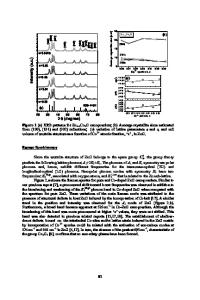Structural, optical, and antibacterial properties of pure and doped (Ni, Co, and Fe) Cr 2 O 3 nanoparticles: a comparati
- PDF / 5,508,409 Bytes
- 22 Pages / 595.276 x 790.866 pts Page_size
- 93 Downloads / 312 Views
ORIGINAL ARTICLE
Structural, optical, and antibacterial properties of pure and doped (Ni, Co, and Fe) C r2O3 nanoparticles: a comparative study Asma Almontasser1 · Azra Parveen1 · Mohd. Hashim1 · Anwar Ul‑Hamid2 · Ameer Azam1 Received: 14 September 2020 / Accepted: 13 October 2020 © King Abdulaziz City for Science and Technology 2020
Abstract Sol–gel method was used to synthesize pure and doped (Ni, Co, and Fe) C r2O3 nanoparticles ( NixCr2-xO3, CoxCr2-xO3, and FexCr2-xO3, where x = 0.00, 0.01, 0.03, 0.05, and 0.07). The structural properties of the prepared samples were determined using x-ray powder diffraction (XRD) with an aim to investigate the influence of doping concentration on the behavior of pure and doped C r2O3 nanoparticles (NPs). The average crystallite size was estimated with Debye Scherrer’s formula. Morphology of pure and doped (Ni, Co, and Fe) C r2O3 nanoparticles was examined using field emission scanning electron microscope (FESEM). Fourier transform infrared spectroscopy (FT-IR) was employed to ascertain surface group species of the samples. UV–Vis spectroscopy was used to determine the energy band gap of samples through optical absorption spectrum. Photoluminescence spectroscopy was undertaken to acquire emission and absorption spectra and determine defects in the structures of all synthesized nanopowder samples. Antibacterial activity of pure and doped (Ni, Co, and Fe) Cr2O3 nanoparticles was investigated against Gram-negative bacteria such as Escherichia coli (E. coli) and Gram-positive bacteria Staphylococcus aureus (S. aureus) using paper disc diffusion method and pour plate procedure. Enhanced anti-bactericidal activity was shown against Gram-negative bacteria compared to Gram-positive bacteria. The minimum and maximum inhibition of E. coli and S. aureus was recorded with 40 and 100 μg/ml of nanoparticles, respectively. Furthermore, irondoped Cr2O3 was more effective in restricting growth of bacterial cell compared to cobalt- and nickel-doped C r2O3. Superior activity observed against E. coli and S. aureus in terms of inhibition make these samples suitable and potential candidates in medical and paint industries. Keywords Doped Cr2O3 nanoparticles · X-ray diffraction (XRD) · UV–Vis spectroscopy · FT-IR and PL
Introduction Metal oxides constitute a significant class of materials that are extensively used in various fields such as magnetism, environmental science, biology, chemical sensors, electrochemistry, etc. Furthermore, transition metal oxide nanoparticles have attracted considerable attention recently due to their unique optical, physical, electrical, chemical and magnetic properties. They are used in several applications * Azra Parveen [email protected] 1
Department of Applied Physics, Z. H. College of Engineering and Technology, Aligarh Muslim University, Aligarh 202002, India
Center for Engineering Research, Research Institute, King Fahd University of Petroleum & Minerals, Dhahran 31261, Saudi Arabia
2
such as superconductors (Cava 2000; Ren et al.
Data Loading...










